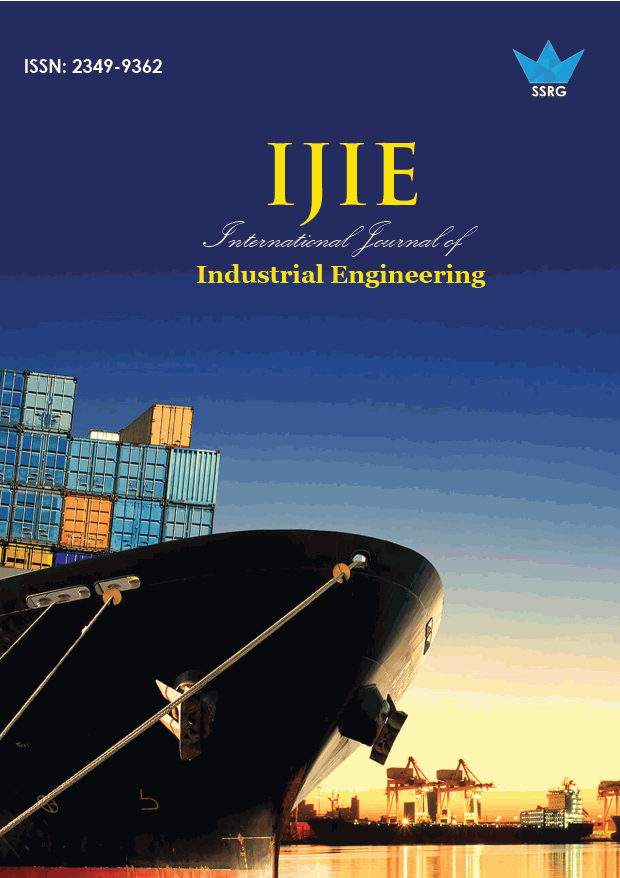Real Power Loss Minimization of AC/DC Hybrid Systems with Reactive Power Compensation by using Self Adaptive Firefly Algorithm

| International Journal of Industrial Engineering |
| © 2020 by SSRG - IJIE Journal |
| Volume 7 Issue 1 |
| Year of Publication : 2020 |
| Authors : Dr.B.Suresh Babu |
How to Cite?
Dr.B.Suresh Babu, "Real Power Loss Minimization of AC/DC Hybrid Systems with Reactive Power Compensation by using Self Adaptive Firefly Algorithm," SSRG International Journal of Industrial Engineering, vol. 7, no. 1, pp. 41-48, 2020. Crossref, https://doi.org/10.14445/23499362/IJIE-V7I1P105
Abstract:
This paper presents a Self Adaptive Firefly Algorithm (SFO) for the solution Real Power Loss ( RPL) Minimization of AC/DC Hybrid Systems with Reactive Power Compensation .The DC links placed in the transmission system involve consumption of reactive power by the converters at both ends. The Reactive Power Flow can be manipulated based on the removing at the end bus it from the system .Optimal Power Flow (OPF) problem is formulated as a nonlinear constrained multiobjective optimization problem where different objectives and different constraints have been considered. Optimal Power Flow with Reactive Power Compensation is an important operational and planning problem in minimizing the RPL of the power systems. It presents simulation results of IEEE14 and 30 test systems with a view of demonstrating its effectiveness.
Keywords:
optimal power flow, AC/DC power flow, firefly optimization, valve point effect
References:
[1] Carpentier, J, “Contribution a l’Etude du Dispatching Economique,” Bulletin de la Societe Francaise des Electriciens, vol. 3, pp.431-474, 1962.
[2] Cong Ji, Zhi-nong Wei, Guo-qiang Sun, Yong-hui Sun, “AC-DC Decoupling Algorithm of Optimal Power Flow with HVDC System,” Applied Mechanics and Materials, vol.457, pp.1107-1112, 2014.
[3] Wang Feng , Le Anh Tuan, Lina Bertling Tjernberg, Anders Mannikoff and Anders Bergman, “A New Approach for Benefit Evaluation of Multiterminal VSC–HVDC Using a Proposed Mixed AC/DC Optimal Power Flow,” IEEE Trans. on Power Delivery, vol.29, no.1, 432-443, 2014.
[4] J.Arrillaga, C.RArnold and B.J.Harker, “Computer Modeling of Electrical power systems,” John Wiley & sons Ltd, pp.168-185, 1983.
[5] K. Mangoli, and K.Y. Lee, “Optimal real and reactive power control using linear programming, Electrical Power System Research,” vol.26, no.1, pp.1-10, 1993.
[6] O.Alsac,and B. Scott, “Optimal load flow with steady state security, IEEE Transactions on power Apparatus and systems,” vol.PAS, pp.745-751, 1974.
[7] Momoh JA and Zhu JZ, “Improved interior point method for OPF problems,” IEEE Trans Power Syst., vol.14, no.3, pp.1114–20, 1999.
[8] Burchett RC, Happ HH and Vierath DR, “Quadratically convergent optimal power flow,” IEEE Trans Power Apparatus Syst., vol.103, pp.3267–76, 1984.
[9] Abdel-Fattah Attia, Yusuf A.Al-Turki and Abdullah M.Abusorrah, “Optimal power flow using adapted genetic algorithm with adjusting population size,” Electric Power Components and Systems, vol.40, pp.1285-99, 2012.
[10] Sood YR, “Evolutionary programming based optimal power flow and its validation for deregulated power system analysis,” Int J Electr Power Energy Syst, vol.29, no. 1, pp.65-75, 2007.
[11] Mahmood Joorabian and Ehsan Afzalan, “Optimal power flow under both normal and contingent operation conditions using the hybrid fuzzy particle swarm optimisation and Nelder–Mead algorithm (HFPSO–NM),” Applied Soft Computing, vol.14, pp.623–633, 2014.
[12] A.V.Naresh babu, T. Ramana and S.Sivanagaraju, “Analysis of optimal power flow problem based on two stage initialization algorithm,” Int J Electr Power Energy Syst., vol.55, pp.91-99, 2014.
[13] Niknam T, Narimani MR, Jabbari M and Malekpour AR, “A modified shuffle frog leaping algorithm for multi-objective optimal power flow,” Energy, vol.36, pp.6420-32, 2011.
[14] Sivasubramani.S and Swarup.KS, “Multi-objective harmony search algorithm for optimal power flow problem,“ Int J Electr Power Energy Syst., vol.33, no.3, pp.745–52, 2011.
[15] Duman S, Güvenç U, Sönmez Y and Yörükeren N, “Optimal power flow using gravitational search algorithm,” Energy Convers Manage, vol.59, pp.86-95, 2012.
[16] B.Srinivasa Rao and K. Vaisakh, “Multi-objective adaptive clonal selection algorithm for solving environmental/economic diaptch and OPF problems with load uncertainty,” Electrical Power and Energy Systems, vol.53, pp.390-408, 2013.
[17] M. Rezaei Adaryani and A. Karami, “Artificial bee colony algorithm for solving multi-objective optimal power flow problem, Electrical Power and Energy Systems,” vol.53, pp. 219-230, 2013.
[18] Mojtaba Ghasemi, Sahand Ghavidel, Mohsen Gitizadeh and Ebrahim Akbari, “An improved teaching-learning-based optimization algorithm using
Levy mutation strategy for non-smooth optimal power flow,” Electrical Power and Energy Systems, vol.65, pp.375-384, 2015.
[19] X. S. Yang, “Firefly algorithms for multimodal optimization,” in Proceedings of the Stochastic Algorithms: Foundations and Applications of Lecture Notes in Computing Sciences, Springer, Sapporo, Japan, vol.5792, pp. 178-178, 2009.
[20] P. Kessel and H. Glavitsch, “Estimating the voltage stability of a power system,” IEEE Trans. Power Deliver, vol.1, no.3, pp.346-54, 2000.
[21] Tahir Nadeem Malika, Azzam ul Asarb, Mudasser F. Wynec and Shakil Akhtar, “A new hybrid approach for the solution of nonconvex economic dispatch problem with valve-point effects,” Electric Power Systems Research, vol.80, pp.1128-1136, 2010.
[22] Jason Yuryevich and Kit Po Wong, “Evolutionary programming based optimal power flow,” IEEE Trans. on Power Systems, vol.14, no.4, pp.1245-1257, 1999.
[23] S. Prabhakar Karthikeyan, K. Palanisamy, C. Rani, I. Jacob Raglend and DP. Kothari, “Security constrained unit commitment problem with operational, power flow and environmental constraints,” WSEAS Trans. on Power Systems, vol.4, no.2, pp.53-56, 2009.

 10.14445/23499362/IJIE-V7I1P105
10.14445/23499362/IJIE-V7I1P105